Werder Bremen and Borussia Monchengladbach have both enjoyed fairly strong starts to the Bundesliga season, although the former may well be happier, as they have only just returned to the top flight.
Seven games into the season, Werder Bremen have won two, drawn three and lost two, and are one of the more entertaining teams to watch in the league due to their high-energy pressing style of football. Only Bayern Munich have scored more than them, which is a testament to the quality of the job their manager, Ole Werner, has done with a squad value only worth more than Schalke and Bochum.
This tactical analysis will explain exactly how Werder Bremen got the better of Borussia Monchengladbach and the reasons why Gladbach got embarrassed. Furthermore, we will look at the tactics Ole Werner used and an analysis of how this perfectly created so many different issues for Monchengladbach.
Lineups
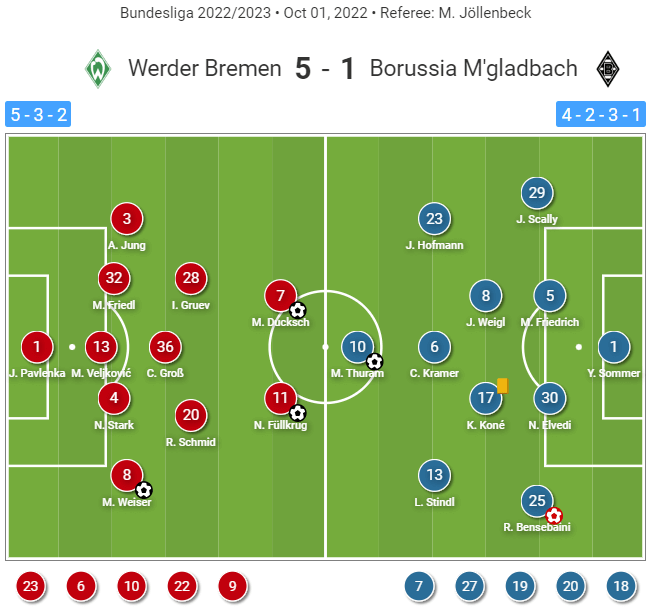
Werder Bremen have continued to use their preferred 5-3-2 tactic, with Niklas Stark coming in to make his debut for the club, whilst the majority of the starting squad stayed the same throughout the season. Ilia Gruev has now kept two starts in a row after breaking into the first-team squad last season.
Borussia Monchengladbach stuck with their 4-2-3-1, where Marcus Thuram was coming in on a good run of form, while Yann Sommer had also had a strong start to the season. Both coaches were happy to stick with their preferred systems throughout the game which shows that the scoreline didn’t entirely reflect the game.
Intense pressing from both sides
The nature of the Bundesliga is a fast-paced and transition-heavy game. This match was no different. From the very start, Werder Bremen looked to press Gladbach intensely and to create chances by winning the ball back in dangerous areas. Ole Werner has encouraged his players to aggressively press the opposing teams, with players matching up man to man, to prevent the goalkeeper from having an easy passing option.
From the image below, we can see the two strikers, five from the midfield line and one centre back all pushing up the pitch to stay close to their opponents. The two wing backs matched up with the opposing full-backs, whilst the midfield three matched up with Gladbach’s three midfielders. Ilia Gruev moved from LCM to mark Weigl, who would move more central, which created some gaps in the areas that Gruev vacated.
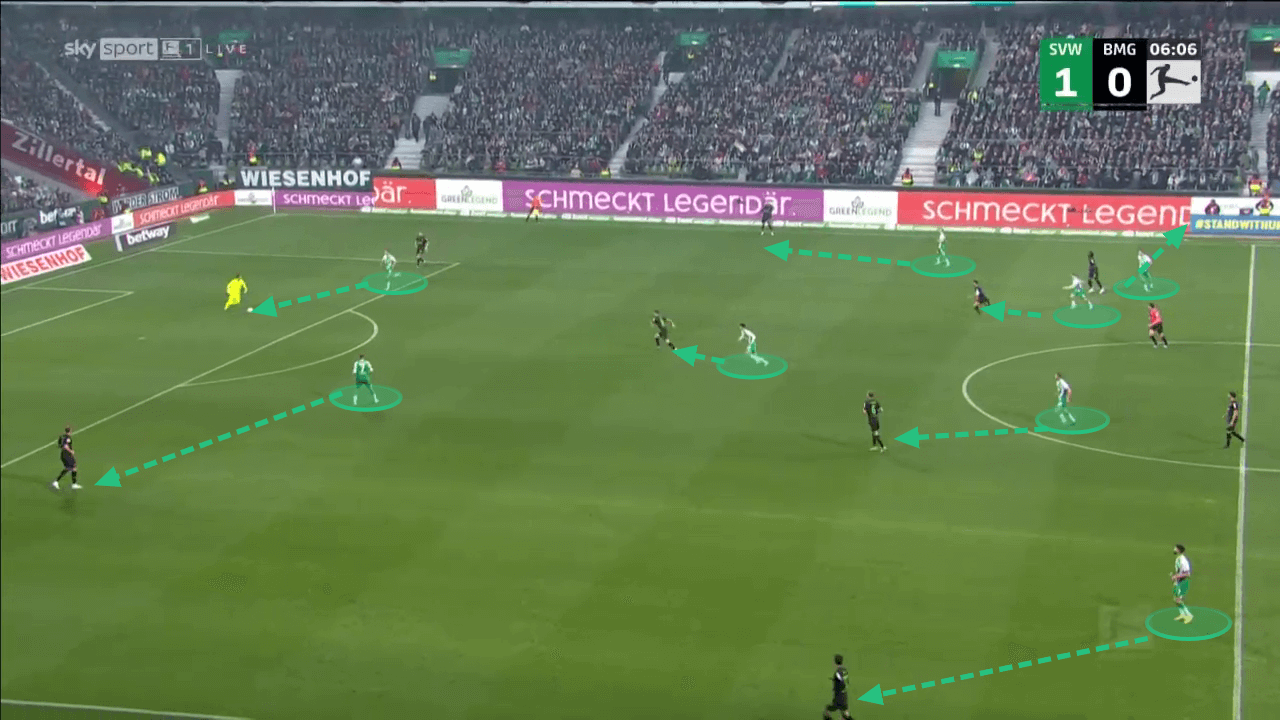
Mitchell Weiser, the right wing-back, has been particularly impressive at aggressively stepping up to his marker and winning the ball back in dangerous areas. The image below shows just how many times Weiser has won the ball back in the first eight games of the season. He has the freedom to press the opposing fullbacks as his RCB can cover the channel down the side if the ball is played over the top.
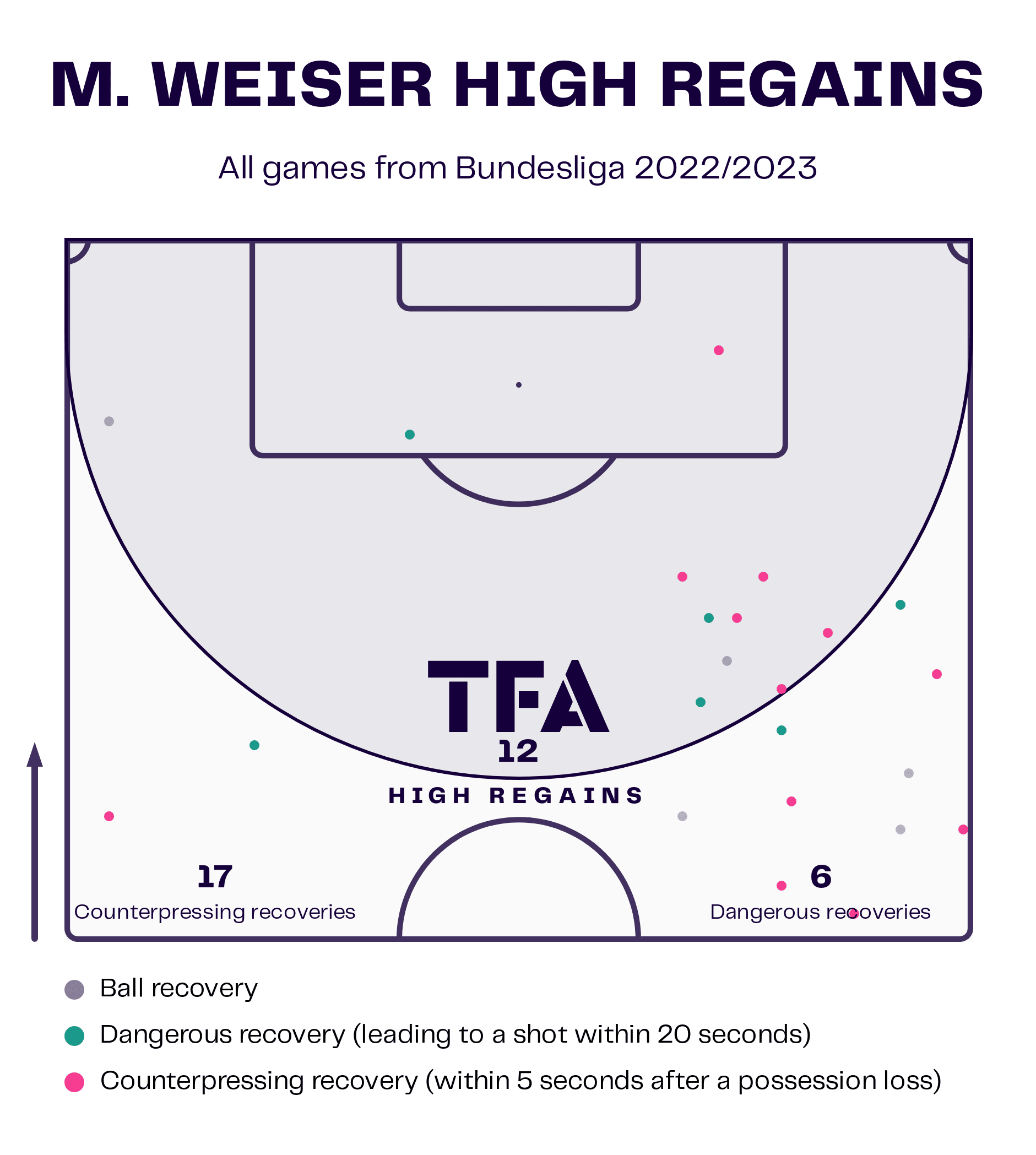
Daniel Farke also encouraged his side to press Werder Bremen high, although his setup put Borussia Monchengladbach at a slight disadvantage. Pressing in a 4-2-3-1, the ex-Norwich City head coach, had his front three matching up with the three central defenders, whilst the midfielders matched up as well.
An issue that Farke faced, was that his wide players started slightly too deep in settled play, which gave opposing wide centre-backs too much time on the ball. The wide players were tasked with preventing passes to the wing backs while also putting pressure on the centre backs. The double shift task was at times too tiring and resulted in Werder Bremen being able to sustain possession of the ball for periods of time.
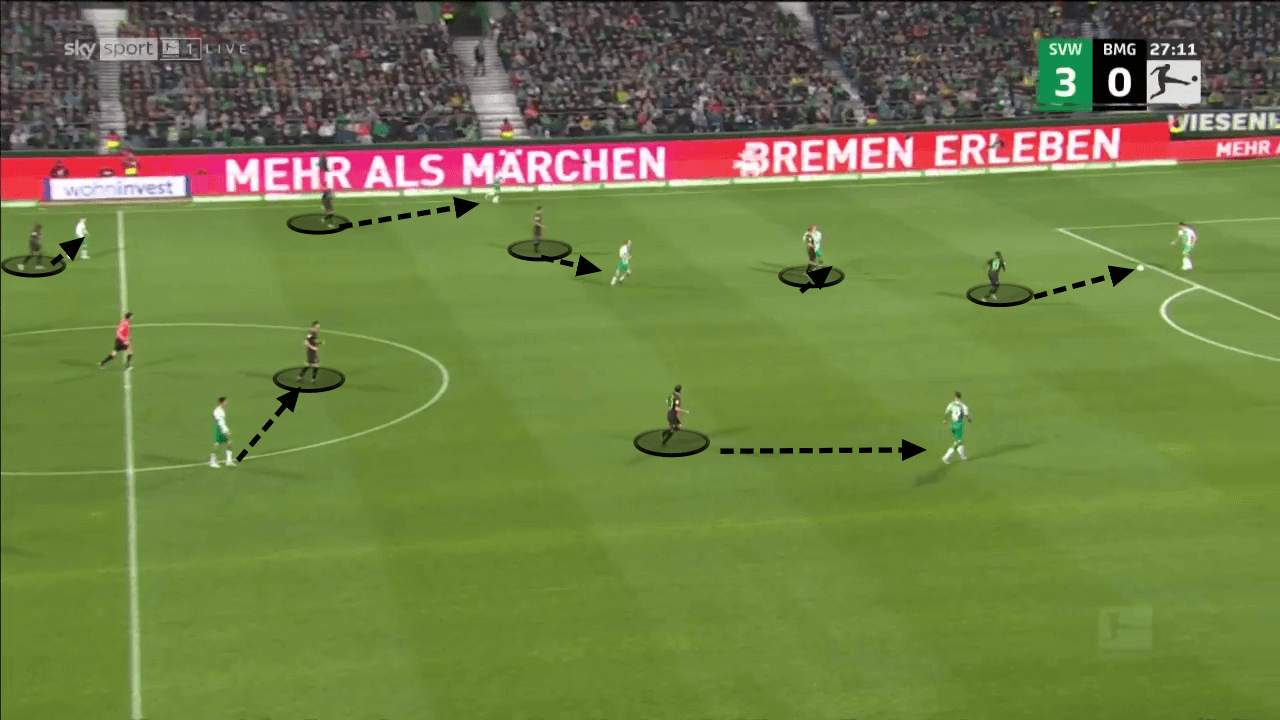
How Werder carved through M’Gladbach
As described earlier, Gladbach at times, struggled with the positioning of the wider players for Bremen. Ole Werner succeeded with the build-up by overloading the Gladbach midfield pivot. Fullkrug was tasked with dropping deep. to cause a 3v2 in the middle of the pitch. The movement of the striker caused problems for Weigl, who had two players to take care of. As a result, Werder Bremen had an easy route for ball progression as the central defender had a free man to pick out, which led to transitional situations frequently.
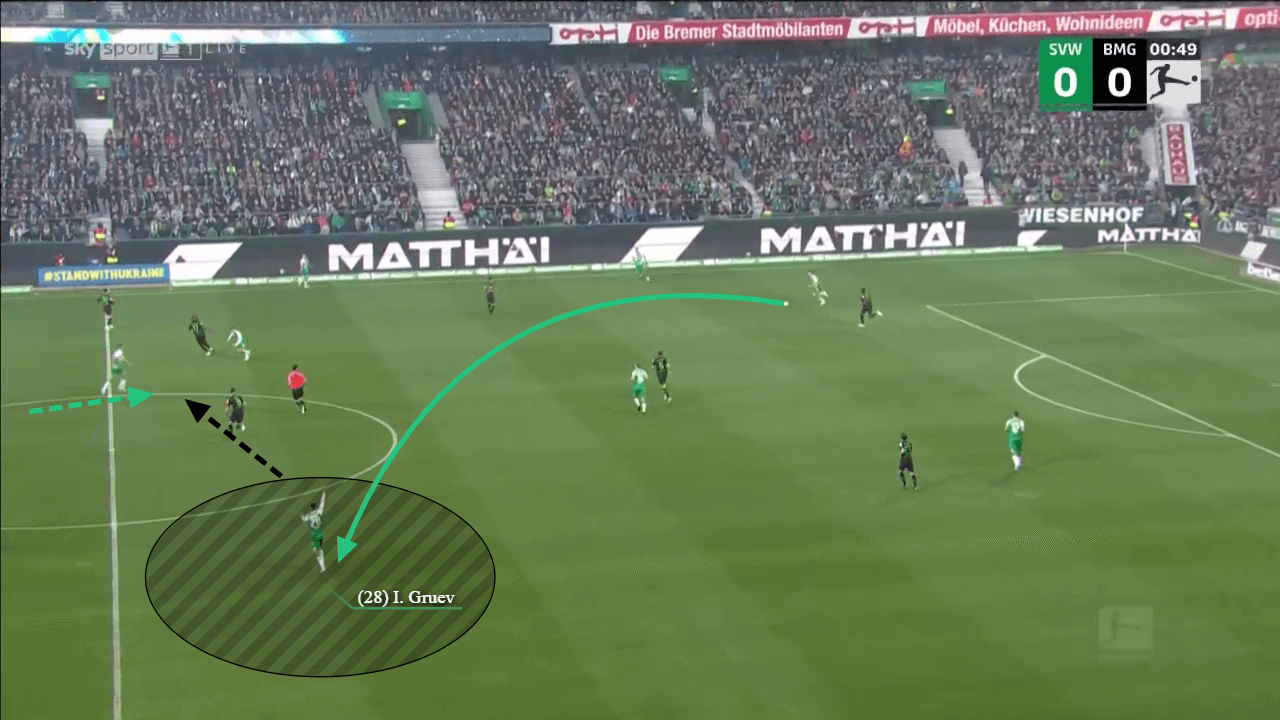
In settled play, Borussia Monchengladbach set up in a 4-4-1-1. As stated earlier, the depth of the two wide players allowed for an easy game for Werder Bremen. At all times, they had a 4v2 against the striker and midfielder from Gladbach. Daniel Farke sacrificed possession of the ball, in order to attempt to prevent Bremen from playing through the block. While this caused central progression to be near impossible, there was too much space sacrificed in wider areas for the plan to be effective.
Ole Werner had set up a number of different patterns for his side to beat the mid-block and break into dangerous areas. With the two Bremen forwards occupying two central defenders, and two wing backs occupying the full-backs, it meant that every player in the Gladbach back line was busy marking, so there was space for runs for deep to be picked out. In the image below, we can see the RCM making a run wide into the channel behind the full-back who was caught in no man’s land between the wing back and the space behind him.
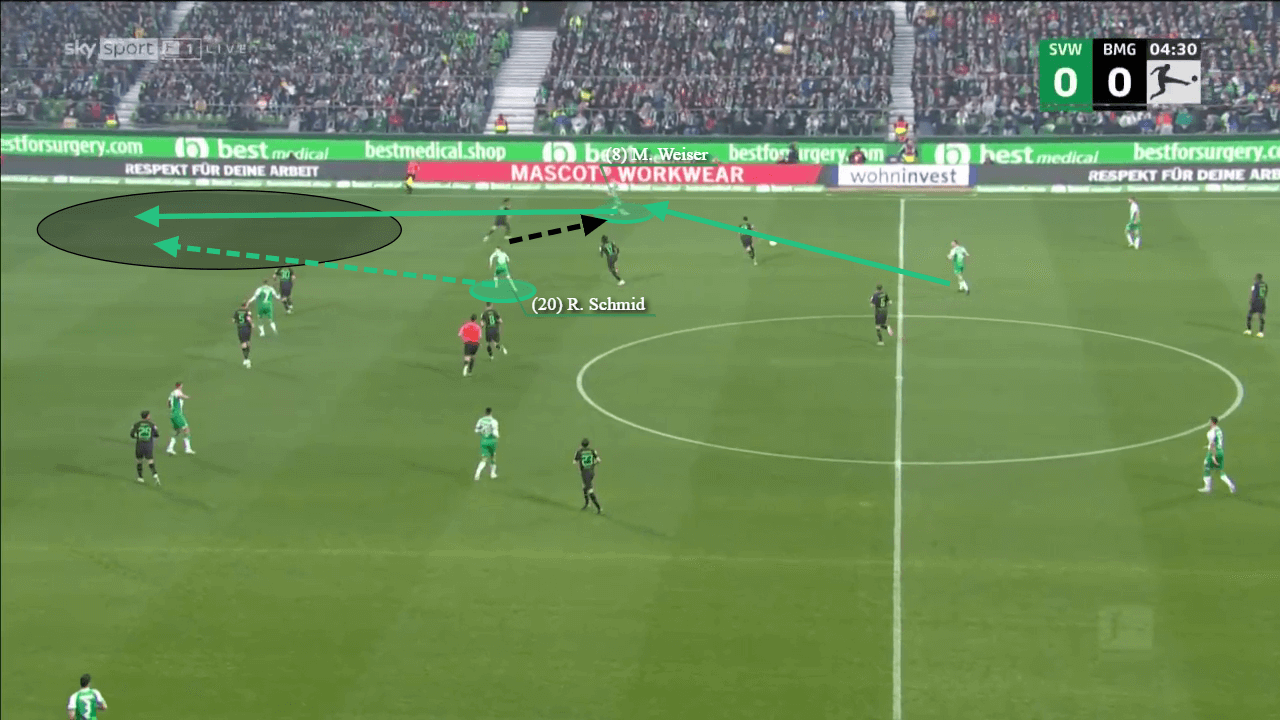
The use of width in attacking areas combined with a lack of pressure meant that the Gladbach was stretched thin and had frequent attacks to defend against. It was very easy to find the player hugging the touchline in attacking areas, from where they could create dangerous opportunities. Niclas Fullkrug is a player who is comfortable with moving into different areas of the pitch, to combine with teammates and find pockets of space from where he could progress play. The image below shows Fullkrug drifting wide, which creates space in the half-space channel, from where Weiser can make an underlapping run into the space behind the back line.
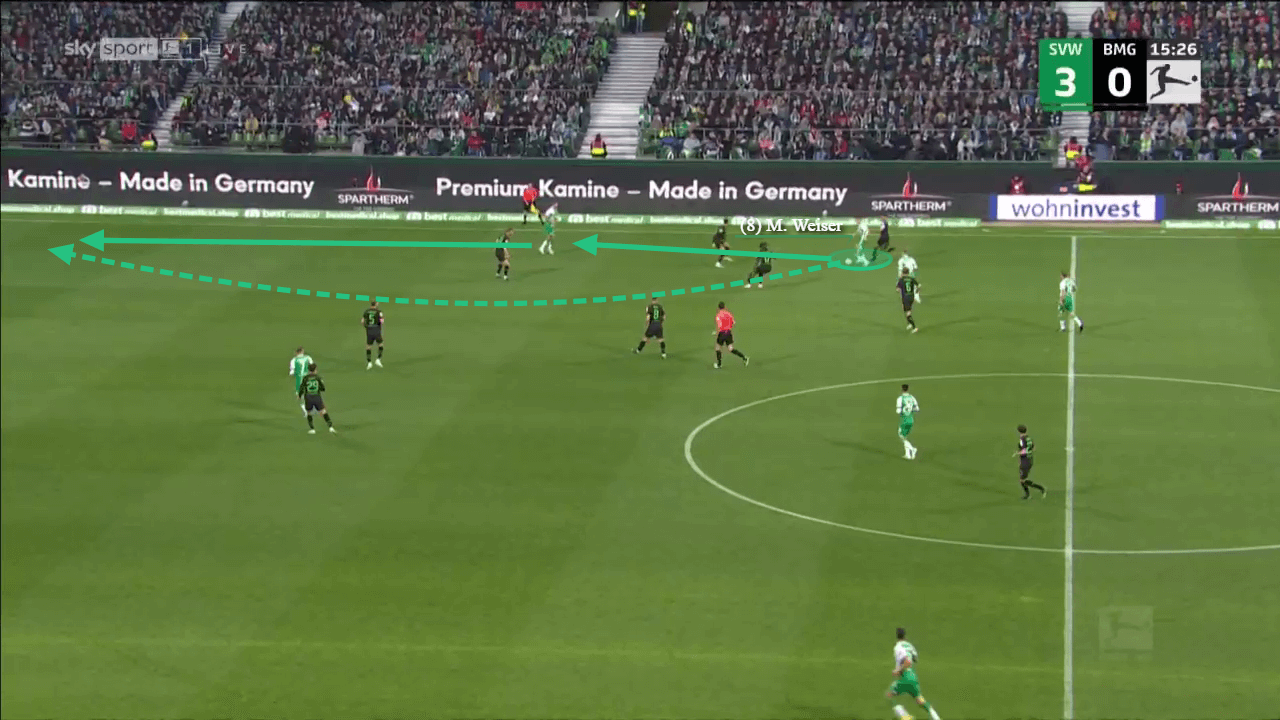
Another method of chance creation, for Werder Bremen against Gladbach’s lacklustre mid-block, was the use of third-man runs. Pictured below, Weiser makes a run darting into the box as his teammate is passing the ball backwards to gain a head start ahead of his opponents on the right-hand flank. There are three Gladbach players, who all are attracted to the ball which makes it very easy for Weiser to control the ball. The lack of cohesion defensively means that some players don’t know when to press and when to sit back, which has led to a confusing start for Farke’s side.
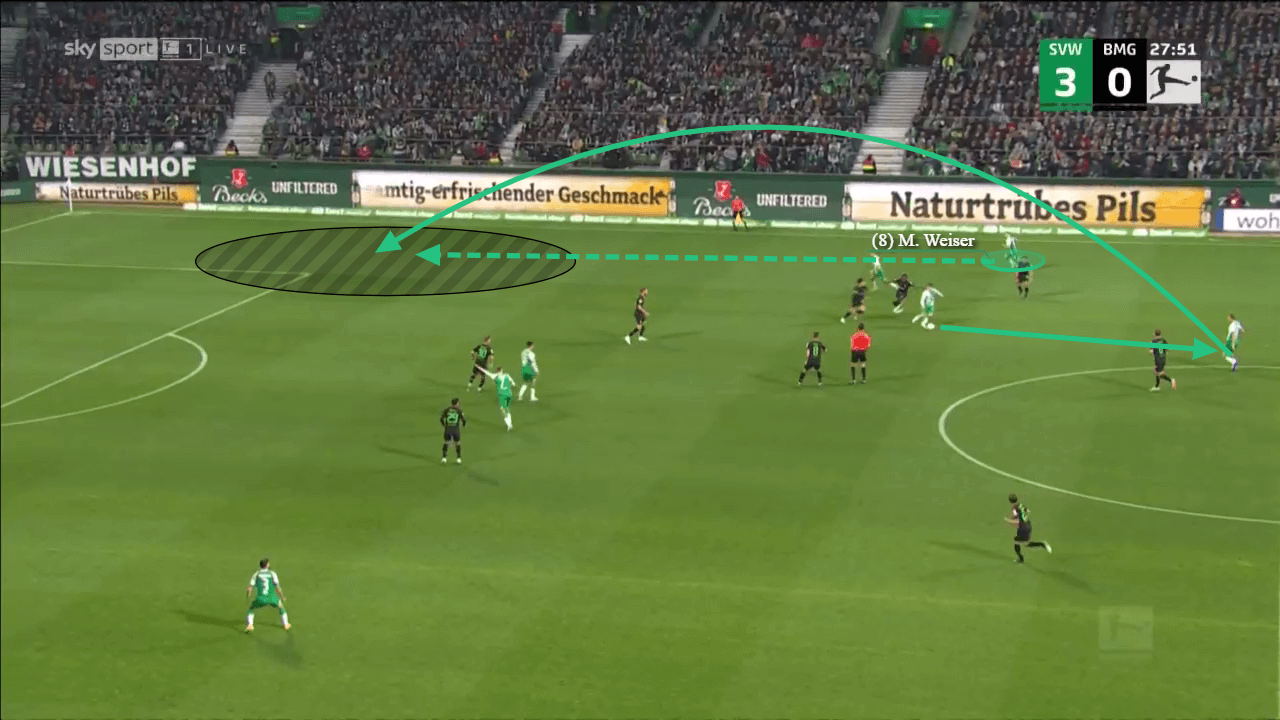
While Werder Bremen have shown signs of good intricate play, there have been times where the press from Gladbach has been very strong and aggressive, forcing Bremen to have to take risks. Ole Werner understands some of the technical limitations of his team, thus leading him to instruct his players to a more direct approach when building play out from the back.
What Werner has done very well, is his ability to instruct his team to be in close proximity of the ball when it is booted long. As seen in the image below, having four players all close to the ball has helped Werder win many more second balls after they are knocked down. This complete approach to playing football means that Bremen are a team who are hard to press, as the pass can be played over all of them, whilst they have also shown the technical ability required to regularly create goalscoring opportunities.
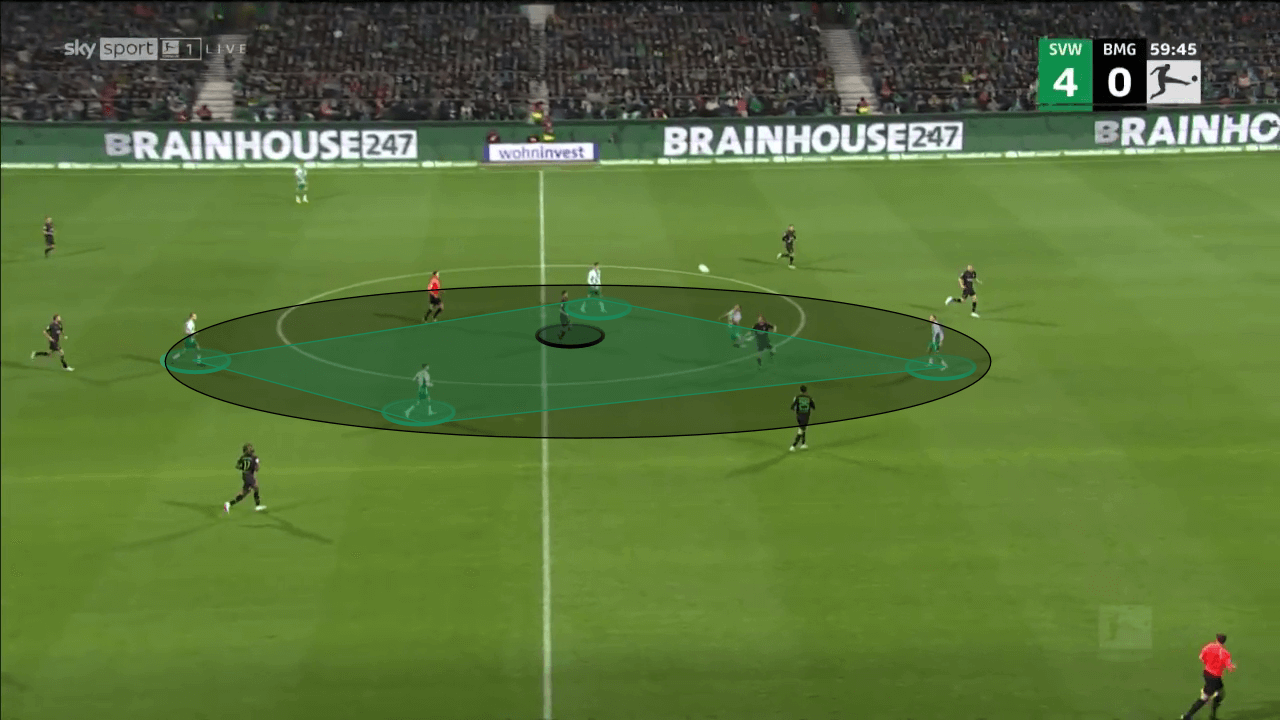
M’Gladbach’s attacking misfortunes
While they may have only scored one goal, Gladbach actually created more xG than Werder Bremen. On average, Gladbach would have won 2.4 – 2.1 against Werder, had the finishing been of a higher standard from some of the Gladbach players. Although the aggressive players saw lots of success, there were periods of time when Gladbach managed to sustain possession due to their superior technical quality across the squad.
The image below shows how Lars Stindl has the ability to control the ball under pressure, turn with it and set up Thuram through on goal who ends up scoring. This approach was largely unsuccessful as the Bremen players usually won the aerial duels, but when the ball was played more to their feet, Gladbach were threatening on the counter, and extremely difficult to stop.
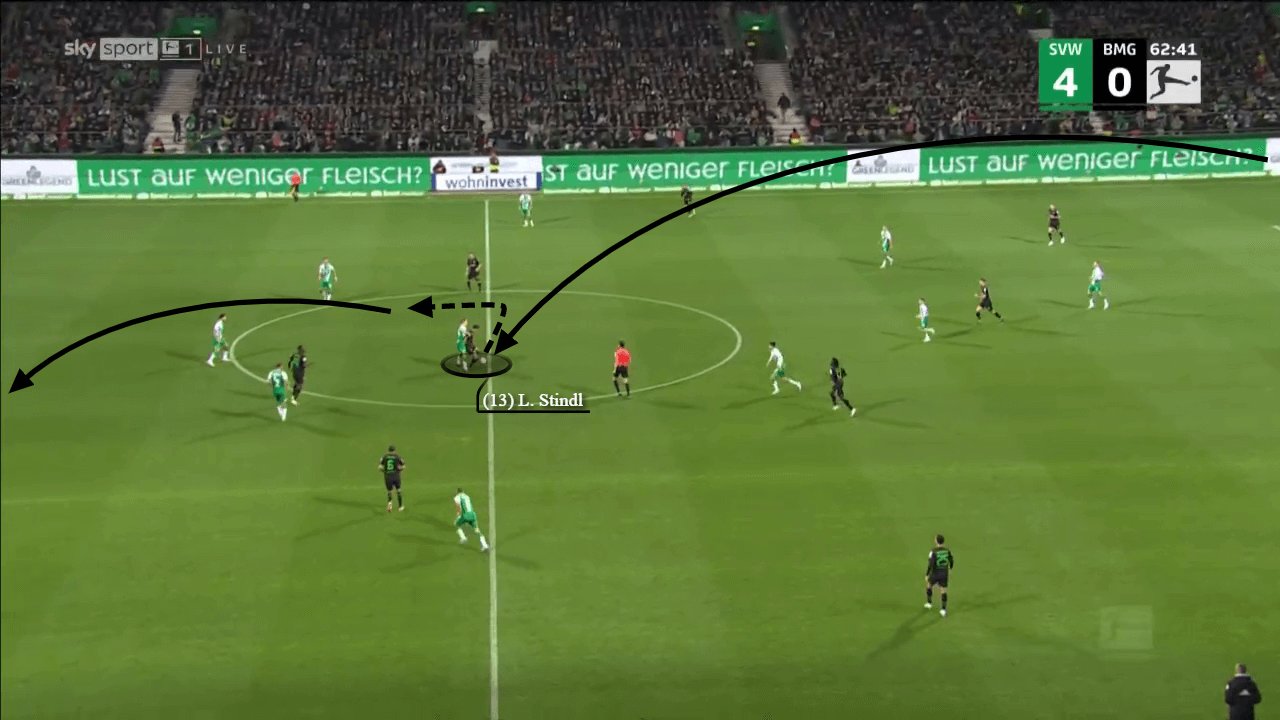
We previously discussed this topic as well, but the movement from LCM to press the back three causes some problems for Bremen. Pressing a player on the ball, from a deep position means that they have extra time on the ball to accurately play a pass before being closed down. This sort of approach is usually the reason why certain pressing structures break down, which shows that the set-up by Ole Werner is one that works against teams with a back two, but is unable to adapt to playing against a back three.
The gap vacated by Gruev, who steps up to press, means that two Gladbach players have acres of space, and are free to receive the ball, turn and make their decision. This has led to Gladbach creating numerous scoring opportunities, although they failed to find the target majority of the time.
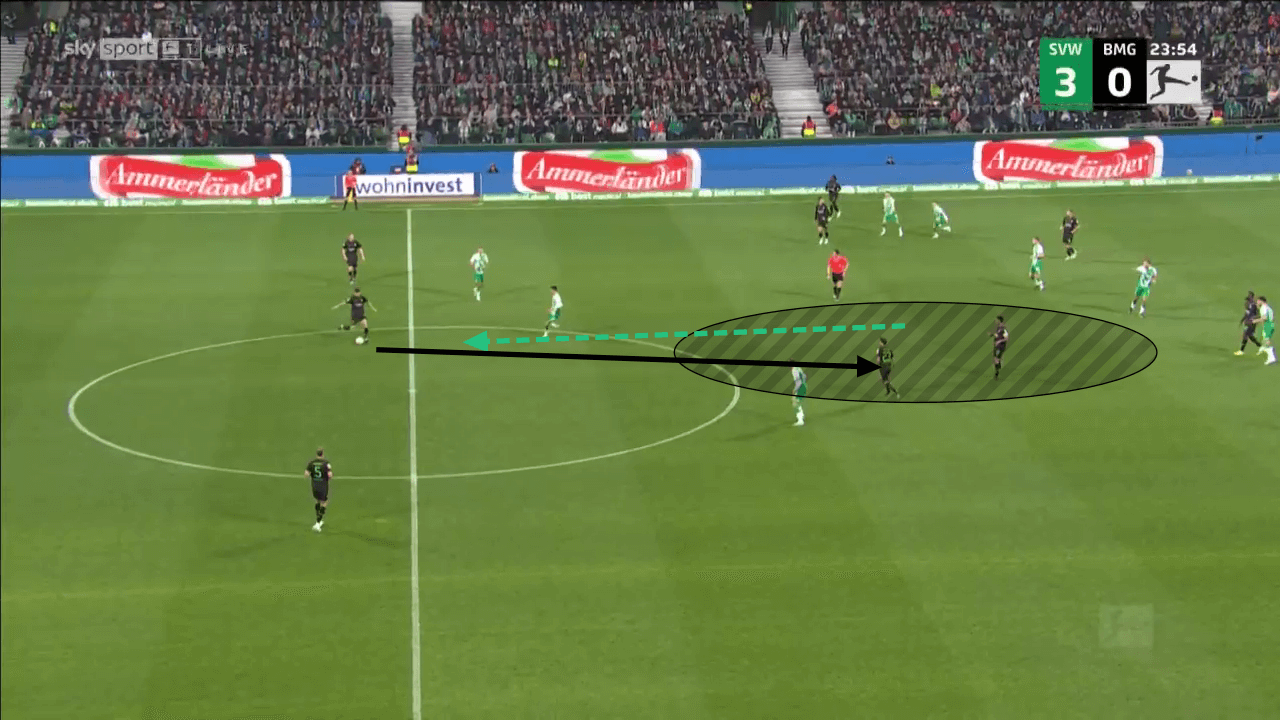
While the intense press from Werder Bremen can be impossible to play through, Gladbach have the players like Kouadio Kone who are press resistant. These players can manoeuvre themselves through oncoming attackers by manipulating the ball, and the orientation of their body.
When pressing man to man, just one player being taken out of the game in a 1v1 situation can unbalance the entire defensive team. The fact that Kone could do this regularly, resulted in Gladbach having numerous opportunities to attack a Bremen side who were all over the place after one person was beaten. This image below shows Kone evading pressure from two players and carrying the ball towards the opposition half, where he can set up more creative players who can affect the final third.
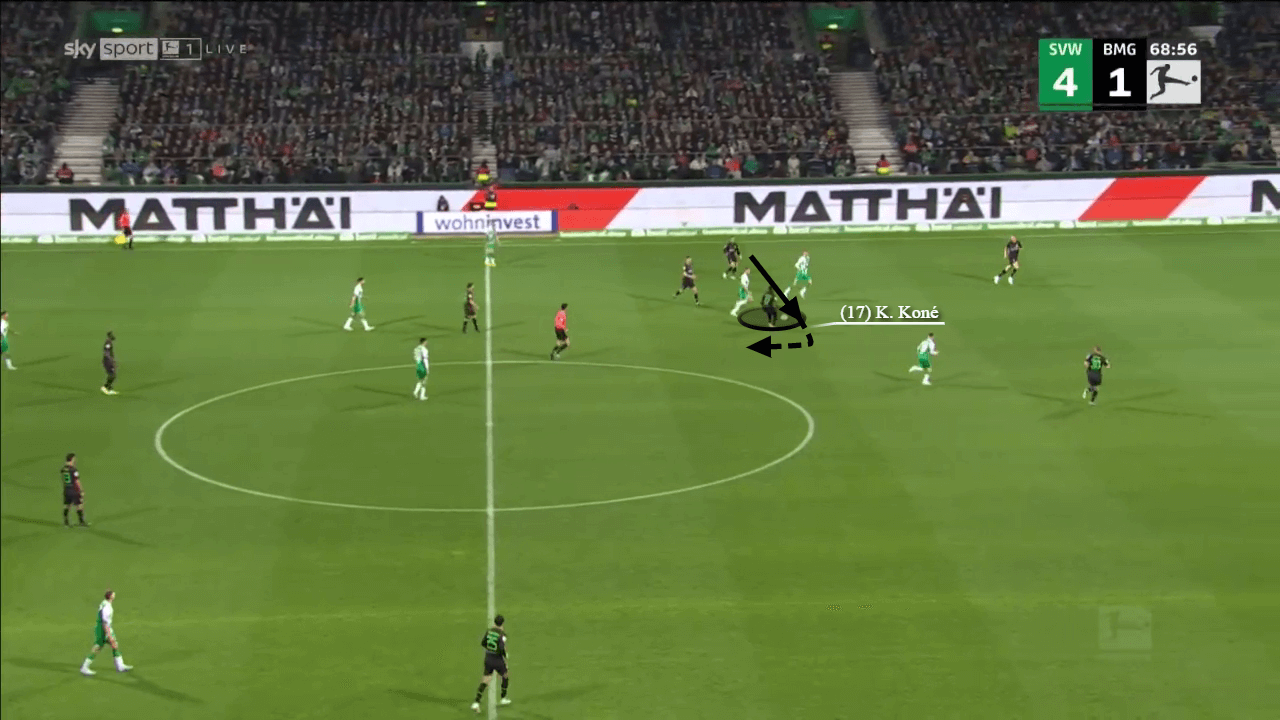
Conclusion
This tactical analysis showed the reasons why Gladbach could not keep up with Werder Bremen. Bremen had the ability to progress play, win aerial duels from long balls, and pressed Gladbach hard enough to stop them from getting much joy in their half. This approach from Werner was successful, although the disparity in technical levels between the two teams was almost enough to allow Gladbach to get back into the game. Werner can’t do much about certain mistakes, and while Gladbach didn’t have their best day in front of goal, they still managed to break through on occasion due to the quality of certain individuals.
Furthermore, the brilliant attacking patterns from Werder Bremen show exactly why they are the second top scorers in the league, and it is likely to carry on, even with players who were regulars in the second tier last season. The fact that they can create so much with players who are not world-class is a credit to the work of the young coach, Werner.






Comments